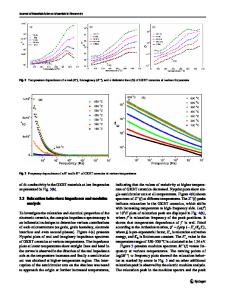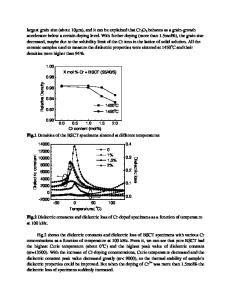Structures, dielectric and ferroelectric properties of Sr 2-x Ca x NaNb 5 O 15 lead-free ceramics
- PDF / 445,955 Bytes
- 6 Pages / 584.957 x 782.986 pts Page_size
- 66 Downloads / 301 Views
The high-density tungsten bronze (TB) Sr2-xCaxNaNb5O15 (SCNN, 0.05 # x # 030) lead-free ceramics were prepared by two-step solid-state reaction method. With increasing Ca21 substitution, the crystal structure of SCNN ceramics slightly distorted from the TB tetragonal phase and became orthorhombic phase at room temperature. The smaller ionic radius of Ca21 (1.34Å) compared with that of Sr21 (1.44Å) contributed to the shrinkage of the crystal structure. Dielectric spectra of all compositions displayed two phase transitions: the ferroelastic orthorhombic to ferroelectric tetragonal phase transition (Te) at lower temperatures, and the ferroelectric to paraelectric phase transition (Tc) at higher temperatures. With increasing Ca21 substitution, Te and Tc shifted towards higher temperature regions, while the maximum values of dielectric constant (eme and em), Pr, Ec and d33 increased at first and then decreased. The ceramics with most homogeneous microstructure and highest density were obtained at x 5 0.15, resulting in optimized properties. I. INTRODUCTION
As one member of the lead-free ferroelectric systems, the family of tungsten bronze (TB) compounds has a chemical formula of (A1)4(A2)2(C)4(B)10O30. In the formula, A1, A2, B and C sites are 15-, 12-, 6- and 9-fold coordinated oxygen octahedral sites in the crystal lattice structure respectively, where A1 and A2 sites can be occupied by Sr21, Ba21, Ca21, Pb21, K1, Na1 and some rare earth cations, B sites by either Nb51 or Ta51, C sites by Li1 and other small cations. The smallest C sites are usually empty, then the formula (A1)4(A2)2(B)10O30 or (A1)2(A2)1(B)5O15 is for the filled tungsten bronze (TB) structure. TB solid solutions can be obtained with either tetragonal symmetry in the ferroelectric phase or orthorhombic symmetry in both ferroelectric and ferroelastic phases. The polar unit of TB compounds is the Nb2O6 octahedron, and the polar axis is parallel to the c-axis. Ferroelectricity in these compounds arises from the interaction between Nb atoms and the oxygen framework in the polar unit. Recently, the TB compounds have received considerable attention owing to their superior electro-optic, piezoelectric, ferroelectric, and pyroelectric properties.1–5 Within the TB family, Neurgaonkar et al.6 have systematically investigated the TB ferroelectric single crystals and considered Sr2-xCaxNaNb5O15 (SCNN, 0.055 x 50.35) to be potential lead-free piezoelectric materials, in which a large piezoelectric constant (d33 5 270 pC/N) a)
Address all correspondence to this author. e-mail: [email protected] DOI: 10.1557/jmr.2012.32 J. Mater. Res., Vol. 27, No. 7, Apr 14, 2012
could be obtained at x 5 0.10. They also found that the structure of SCNN crystal slightly distorted from the tetragonal phase and became orthorhombic phase at room temperature. However, applications of single crystals with excellent electric properties are limited due to their high cost and difficulty in fabrication. On the contrary, ceramics can be made into larger and more complex components at lower cos
Data Loading...











